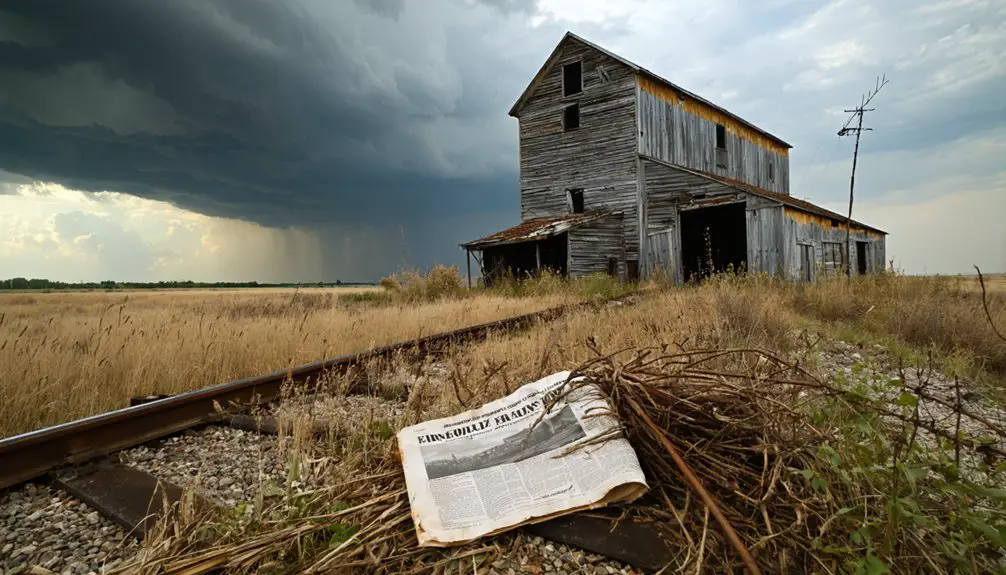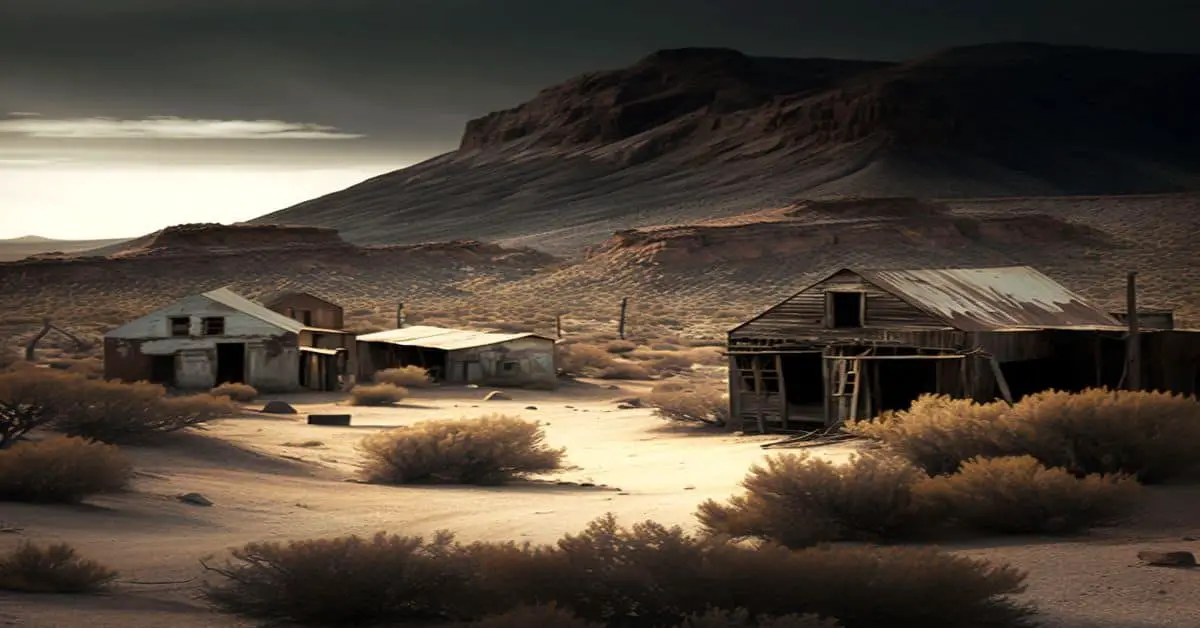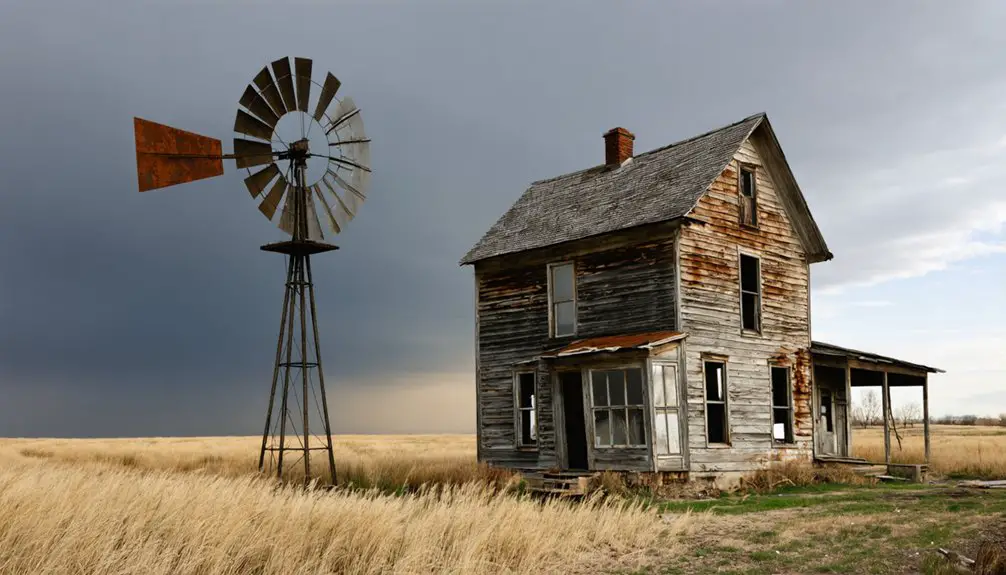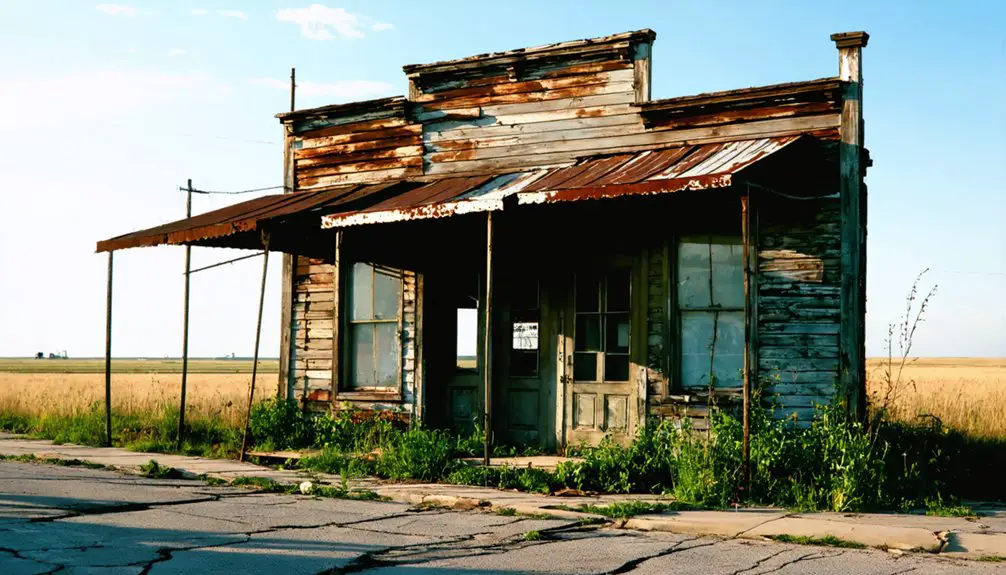You’ll find Roscoe nestled along Nebraska’s South Platte River, a Union Pacific Railroad water stop from the 1870s that’s now a semi-ghost town. The historic site spans 0.16 square miles, featuring original storefronts and grain elevators from its heyday along the Lincoln Highway. While fewer than 65 residents remain, Chamberlin’s store and other preserved buildings tell rich tales of steam locomotives, Scottish settlers, and small-town resilience in America’s heartland.
Key Takeaways
- Roscoe began as a Union Pacific Railroad water stop in the 1870s, serving steam engines along the South Platte River.
- The town’s original storefronts and buildings remain largely intact, preserving classic railroad-era architecture from the 1870s.
- Heman “Ben” Chamberlin established key businesses including a general store, rental cabins, and gas station around 1910.
- The population has dwindled to fewer than 65 residents, creating a ghost town atmosphere with quiet streets and abandoned buildings.
- Historic structures serve as unintentional museums, featuring preserved artifacts like vintage signage and original architectural details.
A Railroad Town’s Birth Along the Lincoln Highway
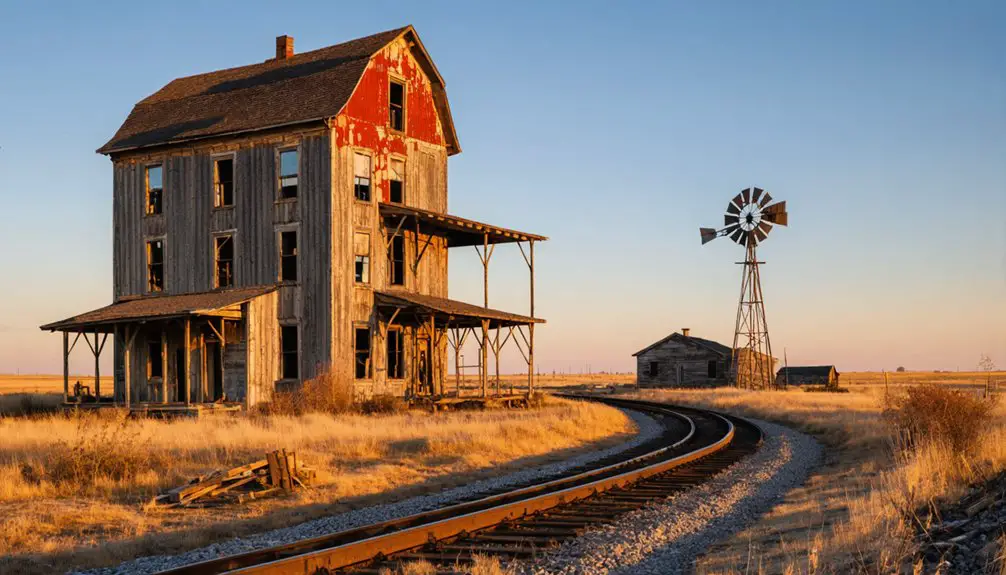
The whistle of steam locomotives first echoed through Roscoe’s future site in the early 1870s, when Union Pacific Railroad established this strategic water stop along its westward expansion.
You’ll find this ghost town’s origins deeply intertwined with Nebraska’s railroad legacy, positioned perfectly along the South Platte River where steam engines needed essential water resupply. Today, the town covers just 0.16 square miles of Nebraska countryside.
As railroad expansion transformed the American frontier, Roscoe emerged as one of many small but significant waypoints supporting Nebraska settlement. The railroad’s presence was crucial as it received major land grants to facilitate westward development and town building.
The town’s placement, about 7 miles east of the cattle hub Ogallala, made it a natural link in the growing transport network.
When the Lincoln Highway later traced the same route as today’s U.S. 30, Roscoe stood at the crossroads of rail and road transportation, marking an era of pioneering mobility across the Plains.
Life on the South Platte River Crossing
While countless emigrants gazed upon the South Platte River‘s deceptively placid surface, they’d soon discover its treacherous nature firsthand.
You’d find yourself facing a braided channel that stretched like an inland sea, with shifting sandbars and quicksand ready to trap your wagon wheels at every turn.
River navigation proved especially challenging at historical crossings near Roscoes, where the swift current could ground your vessel on hidden bars. The Overland Trail route followed this dangerous crossing as pioneers pushed westward.
Hidden sandbars lurked beneath the South Platte’s surface at Roscoes Crossing, ready to snare unwary vessels in their turbulent grasp.
Whether you chose to ford the shallow waters or pay for a ferry crossing, you’d contend with the same rumbling journey across the rocky riverbed that stagecoaches endured.
Before the arrival of steel bridges, you’d rely on temporary solutions like sod bridges, which spring floods and ice jams would regularly destroy, reminding you of nature’s persistent dominance over human ambition.
The first permanent structure appeared when the Plum Creek bridge was constructed in 1873, marking a new era of reliable river crossings.
The Chamberlin Legacy and Local Commerce
At the heart of Roscoe’s commercial life stood Heman “Ben” Chamberlin, a Michigan native who’d establish himself as the town’s prominent merchant around 1910. Similar to his relative Ross Oliver Chamberlin, he hailed from Michigan where their family had deep roots.
The Chamberlin Heritage ran deep through Roscoe’s veins, with roots tracing back to Scottish settlers who’d ventured across America’s expanding frontiers. Like many families of the era, they were among the Non-Conformist immigrants who sought religious freedom in the New World.
The family’s Economic Impact on Roscoe was substantial, operating multiple ventures that served both locals and travelers:
- A general store providing essential goods
- Rental cabins for wayfarers
- A gas station serving motorists until the early 2000s
- Additional commercial properties along main thoroughfares
You’ll find evidence of the family’s lasting influence in the preserved buildings that still stand, including their gas station with its eclectic decorations – from Packers memorabilia to Grateful Dead stickers – telling stories of generations who kept Roscoe’s commerce alive.
Preserved Architecture Through Time
You’ll find several original storefronts from Roscoe’s railroad heyday still lining the main thoroughfare, their brick and wood construction having weathered decades of Nebraska’s harsh elements.
The buildings’ resilience owes much to the quality materials and practical construction methods used by 1870s builders, who understood the region’s climate demands. Like the abandoned buildings of Main Street, these remnants tell the story of a once-thriving community.
The architectural details, from false fronts to large display windows, showcase classic railroad-town design elements that served both commercial function and visual appeal during the town’s bustling years.
Located along Highway 30, Roscoe provides easy access for visitors wanting to explore these historic structures.
Historic Storefronts Still Standing
Several historic storefronts in Roscoe, Nebraska stand as remarkably preserved remnants of the town’s railroad-era prosperity, including the iconic Chamberlin’s store operated by H.S. “Ben” Chamberlin and his son Harvey in the early 1900s.
Similar to how abandoned factories still define Prattville, Alabama’s landscape today, these storefronts serve as time capsules of small-town industry.
While entering buildings is prohibited, visitors can still appreciate the architectural details and historical significance from the street.
The historic preservation of these structures offers you a glimpse into rural Nebraska’s commercial past, with local artifacts still visible through intact windows and doorways.
You’ll find these buildings have weathered time surprisingly well, with minimal vandalism and structural damage.
Inside, you can spot:
- Original storefront cabinets and service equipment
- Personal touches like Green Bay Packers wind chimes
- A September 11 remembrance poster from 2001
- Grateful Dead stickers and railroad-era signage
These storefronts tell the story of Roscoe’s evolution from a bustling railway town to today’s quiet community of fewer than 65 residents.
Weather-Resistant Building Materials Endure
The remarkable durability of Roscoe’s historic buildings stems from their weather-resistant construction materials and techniques.
You’ll notice the town’s sturdy stone walls, built with locally reclaimed rock and lime mortar, have withstood decades of Nebraska’s harsh climate. These weather-resistant materials demonstrate exceptional masonry resilience, allowing the structures to flex with temperature changes while preventing moisture damage.
The buildings’ survival also owes much to their thoughtful design features. Extended eaves protect the walls from driving rain, while strategic window placements maximize natural ventilation.
Original wood elements remain intact thanks to period-appropriate treatments and protective coatings. The builders’ wise use of compatible materials – matching thermal expansion rates and moisture permeability – has prevented the structural stress and deterioration that typically doom abandoned structures.
Railroad Era Design Elements
While Roscoe’s prominent buildings showcase classic railroad-era architecture from the 1870s, their purposeful design directly supported the Union Pacific line‘s operations.
You’ll find that Chamberlin’s store, grain elevators, and Most Hall exemplify the railroad architecture that defined frontier commerce, with their strategic placement along the tracks maximizing accessibility for steam locomotives and crews.
The legacy preservation of these structures reveals key railroad-era features:
- Main streets and storefronts positioned parallel to rail lines
- Durable construction using local materials and craftsmanship
- Multifunctional spaces serving both commercial and residential needs
- Water source integration near the South Platte River for steam engines
Today, while no longer actively used, these buildings stand as evidence of the quality construction that helped establish Nebraska’s railroad heritage, maintaining their structural integrity despite decades of abandonment.
Tales From Abandoned Main Street
Peering through dusty windows along Roscoe’s abandoned Main Street, you’ll find scenes frozen in time from the town’s gradual decline. Unlike many ghost towns that inspire tales of ghostly encounters or urban legends, Roscoe’s storefronts tell simpler, more human stories.
The Chamberlin family’s old gas station still displays a 9/11 remembrance poster, while a faded Grateful Dead sticker hints at the town’s later years.
You can trace the community’s evolution through these abandoned spaces – from railroad boom town to highway stop, finally succumbing to changing times. While descendants of original families still live nearby, they’ll tell you about Main Street’s busier days serving rail workers and travelers, rather than supernatural tales.
The buildings stand remarkably untouched by vandals, preserving authentic glimpses into rural Nebraska’s past.
Weather-Worn Treasures and Untold Stories
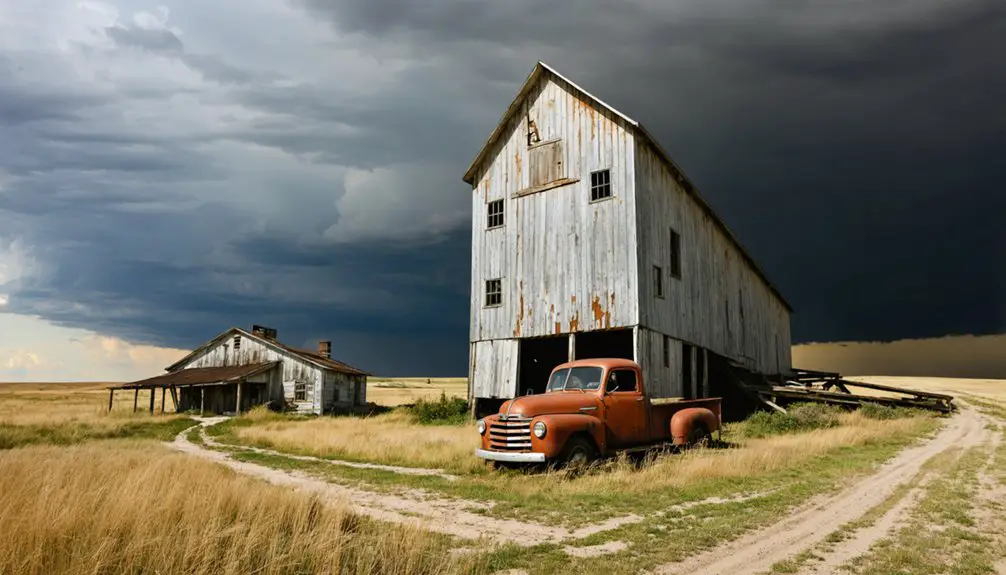
You’ll find weathered storefronts along Roscoe’s main street that have endured decades of Nebraska’s harsh climate, from bitter winters to scorching summers, yet remain surprisingly intact.
Inside these time-worn structures, artifacts like lace curtains and vintage gas station memorabilia tell stories of the town’s evolution from its 1870s railroad origins through its final days in the early 2000s.
The buildings serve as unintentional museums, preserving fragments of local life through items like Green Bay Packers wind chimes and 9/11 remembrance posters that connect you to the personalities who once called this ghost town home.
Preserved Through Nature’s Elements
Throughout decades of abandonment, Roscoe’s structures have quietly weathered Nebraska’s extreme climate, creating an unintentional outdoor museum of preserved artifacts and architecture.
You’ll find remarkable natural resilience in these buildings that have endured harsh weather patterns, from bitter winters to scorching summers.
Inside these weather-worn treasures, you’ll discover fascinating remnants of daily life, preserved as if frozen in time:
- Original lace curtains still hanging in windows
- A Green Bay Packers wind chime swaying in the breeze
- September 11th memorial posters from 2001
- Vintage Chamberlin’s store signage
Nature’s slow reclamation adds character while protecting these structures from human interference.
Surrounding vegetation creates a protective barrier, while the semi-arid climate helps preserve interior artifacts that tell stories of those who once called Roscoe home.
Time Capsules Inside Buildings
Inside Roscoe’s abandoned buildings, time capsules of local history wait to be discovered. You’ll find preserved treasures in former commercial spaces – from gas stations to the Chamberlin family’s general store – where time capsule discoveries reveal snapshots of daily life from the 1870s through the late 20th century.
Unlike outdoor artifacts exposed to harsh elements, these indoor sanctuaries protect delicate historic memorabilia. Paper posters, Green Bay Packers wind chimes, and Grateful Dead stickers tell stories of residents’ passions and memories.
September 11 remembrance notices speak to the community’s connection to national events. While exteriors weather away, the buildings’ remote location has kept their interior collections remarkably intact, offering you glimpses into the evolution of this railroad town from its bustling heyday to its quiet present.
Cultural Footprints in a Semi-Ghost Town
Despite its diminished population, Roscoe’s cultural legacy endures through a rich tapestry of artifacts and structures that tell the story of its evolution from a bustling railroad town to a semi-ghost town.
Walking through Roscoe today, you’ll discover historical artifacts that paint a vivid picture of its cultural significance, from vintage Green Bay Packers wind chimes to Grateful Dead stickers.
The Chamberlin family’s influence remains visible in the preserved storefronts and signage, while the old gas station stands as a symbol of early 20th-century commerce.
Notable cultural elements include:
- The 1922 Warren Lake Monster hoax, commemorated in local murals
- September 11th memorial posters, connecting the town to national events
- Original business signage from the Chamberlin enterprises
- Railroad-era architecture along the Lincoln Highway
The Last Residents of Roscoe
If you’d visited Roscoe in its final inhabited years, you would’ve found the Chamberlin family maintaining their century-old store and gas station while preserving artifacts of the town’s railroad heritage.
The last residents adapted to increasing isolation by taking on multiple roles in the community, much like other fading Nebraska towns where remaining inhabitants become caretakers of local history.
Through family stories and well-preserved buildings that escaped vandalism, you can still witness how Roscoe’s final occupants balanced modern life with their role as guardians of their town’s legacy.
Modern-Day Town Life
While Roscoe’s ghost town reputation might suggest complete abandonment, a small but resilient community of around 62 residents still calls this unincorporated Nebraska settlement home.
The quiet 0.16-square-mile community exemplifies rural identity through its mix of longtime families and newcomers who’ve chosen to preserve their piece of prairie history.
You’ll find daily life revolves around:
- Self-reliant residents maintaining their properties and watching over historic structures
- Strong bonds between neighbors who share both past and present
- Regular commutes to nearby towns for work and essential services
- A slower pace that reflects traditional rural values
Despite limited infrastructure and commercial activity, the tight-knit population remains committed to their hometown, protecting its character while adapting to modern challenges of rural living.
Preserving Family Heritage
Through the committed efforts of its last residents, Roscoe’s family heritage remains alive in the weathered storefronts and preserved artifacts that line its quiet streets.
You’ll find the Chamberlin legacy particularly evident, from their original store to the abandoned gas station still holding treasures like 9/11 remembrance posters and Grateful Dead stickers.
Despite heritage challenges faced by Roscoe’s remaining 60 residents, family traditions endure in surprising ways.
The Chamberlin name, beginning with H.S. “Ben” Chamberlin in 1910, continues through the preserved buildings his family operated.
Inside these structures, protected from vandalism by respectful visitors, newspapers and personal items tell stories of railroad days and highway commerce.
These physical remnants serve as essential links between past and present, maintained by descendants who understand their role as keepers of Roscoe’s history.
Adapting to Solitude
The last residents of Roscoe have mastered an art that few modern Americans understand – the quiet dignity of small-town solitude. With fewer than 65 neighbors scattered among the well-kept historic buildings, you’ll find that solitary routines become a cornerstone of daily life.
Living in Roscoe means embracing a lifestyle where you’ll need to:
- Master self-sufficiency for basic needs
- Create your own entertainment in the rural quiet
- Maintain strong bonds with the few neighbors you have
- Develop resilience against isolation through community connections
You’ll discover that while modern amenities may be scarce, there’s a profound freedom in this simplified existence.
The remaining residents have adapted to this peaceful solitude, finding strength in their shared heritage and the authentic connections that only a small, close-knit community can provide.
From Bustling Hub to Silent Streets
During its heyday in the late 1800s, Roscoe bustled with activity as steam locomotives rolled in to refill their water tanks from the South Platte River.
You would’ve found the town’s main street alive with commerce, anchored by Chamberlin’s store and the imposing grain elevators built by settler Henrique Most. Railroad expansion brought promise to this strategic stop along the Lincoln Highway.
But like many small railroad towns, you’ll now find Roscoe’s streets hauntingly quiet.
As transportation shifted from rail to roads, businesses shuttered and residents drifted away.
Today, this ghost town‘s abandoned buildings stand as silent sentinels, their weathered facades telling stories of a bygone era when the whistle of approaching trains meant prosperity and possibility.
Exploring Yesterday’s Nebraska Today
Walking through Roscoe today offers a fascinating glimpse into Nebraska’s railroad history, where time seems frozen in the weathered storefronts and quiet streets.
You’ll discover remarkable evidence of community resilience in the structures that still stand, including the Chamberlin family store and its adjacent buildings.
What you’ll find in Roscoe’s abandoned structures:
- The old gas station with its preserved Grateful Dead sticker and Packers wind chime
- Historic homes with original lace curtains still hanging in windows
- A converted railroad right-of-way that’s now a hiking trail
- The Chamberlin store, representation of early 20th-century commerce
You can explore freely among these remnants of pioneer life, where artifacts from different decades tell stories of Nebraska’s evolution from bustling railroad town to peaceful semi-ghost town.
Frequently Asked Questions
Are There Any Paranormal Activities Reported in Roscoe’s Abandoned Buildings?
You won’t find documented ghost sightings or haunted history in Roscoe’s abandoned buildings. While Nebraska has many paranormal hotspots, research shows no verified supernatural activity in this former railroad town’s remains.
What Happened to the Original Town Records and Documents?
Your guess is as good as mine regarding the original documents – historical archives don’t show clear records of their fate. They’ve likely vanished into thin air or moved to nearby county offices.
Can Visitors Legally Enter and Explore the Abandoned Buildings?
You can’t legally explore these abandoned structures without permission – it’s considered trespassing on private property and could result in criminal charges. Stick to viewing the buildings from public roads.
Were Any Movies or Television Shows Ever Filmed in Roscoe?
You’ll find significant film history in Roscoe, particularly “Butch Cassidy and the Sundance Kid,” plus several 1940s productions when producer Harry Sherman owned the town, though television adaptations weren’t documented there.
Did Any Notable Historical Figures Pass Through or Stay in Roscoe?
Of thousands who traveled nearby routes, you won’t find famous residents or nationally notable figures in Roscoe’s history. The Chamberlin family merchants were the most documented locals through archival records.
References
- https://www.youtube.com/watch?v=l3s2qhSxis8
- https://www.placesthatwere.com/2016/07/abandoned-relics-of-past-in-roscoe.html
- https://www.ghosttowns.com/states/ne/roscoe.html
- https://www.pinterest.com/pin/abandoned-buildings-in-roscoe-ne–636907572297243421/
- https://www.youtube.com/watch?v=q1Bww945Vhc
- https://llcgs.info/cpage.php?pt=51
- https://usgennet.org/usa/ne/topic/railroads/history.html
- https://en.wikipedia.org/wiki/Roscoe
- https://en.wikipedia.org/wiki/Great_Platte_River_Road
- https://nebraskapublicmedia.org/es/news/news-articles/bridging-the-platte-river/
